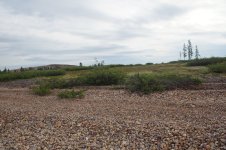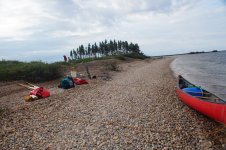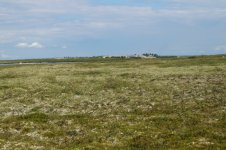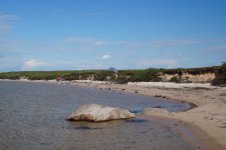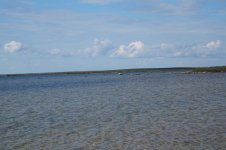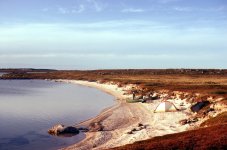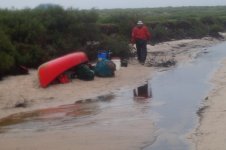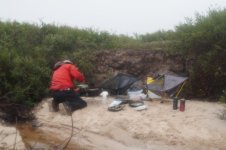Tuesday, July 19. Windy and overcast at 5:30 a.m.
We were only 0.1 minutes south and 0.6 minutes east of the destination coordinates I entered yesterday, and yet the GPS indicated that we were 511 metres (559 yards) away. I wondered how much latitude distance there is in 0.1 minutes. (Note: I checked back in Preeceville, and 0.1 minutes equals a latitude distance of 185 metres (609 feet). So 0.1 minutes is not all that close.)
I then asked the GPS to “GOTO” our current location, and it said we were already there. That’s not too surprising, as the GPS should know its own current location. I’m still confused, though, about why it could not lead us to the desired coordinates yesterday. A similar situation occurred when we arrived at the Lynx Tundra Lodge on July 13. Using coordinates given to me by the lodge’s owner, the GPS indicated that we were still 641 metres (701 yards) away from the lodge. Why would that be? I remained perplexed.
Wind continued to assault our position at 7:00 a.m. Kathleen and I were reluctant to get out of the tent, which shook, shuttered, flapped and billowed. Even though it stood firm, I was worried. How much could the tent take? I lay awake restlessly in my sleeping bag. Too difficult to nap or rest comfortably with all that noise. Kathleen and I plan to check into the Chateau Nova Hotel in Yellowknife tonight. We enjoyed staying there when we came off the East Arm of Great Slave Lake in 2017. At least we hoped to check in tonight. The wind continued at 9:00 a.m.
The wind persisted at 10:30 a.m when I called Stephen, and gave him our coordinates reported by the satellite phone: 62º 20.54’ N, 105º 59.26’ W. Perhaps the satellite phone readings are more accurate than my GPS. Stephen said, “The weather reports in Yellowknife are bad. Flights are being cancelled. What’s the ceiling like out there Michael? We need 300 feet.”
“I think the ceiling is much more than 300 feet, Stephen. Visibility is quite good, I think.”
“That’s great to hear. The plane has left, and should be there around one o’clock.”
Kathleen and I took down the tent, and packed up all our gear. We then snacked on gorp.
The float plane appeared at 2:00 p.m. To me it seemed more like a rescue plane than a pickup plane. We were more than ready to get to Yellowknife. The plane dipped toward the water, but then rose again and flew off to the south. Minutes later it returned, dipped toward the water, but then rose again and flew off to the east. The plane repeated this process for the next twenty minutes or so, when it buzzed us low overhead, and flew off to the south. Minutes later we could no longer hear the engine.
Where could the plane be? Why didn’t it even try to land? We cocked our ears to the south, but could hear only wind. Five minutes later I called Stephen.
“The plane flew away, Stephen. It doesn’t seem to be coming back.”
“There were too many rocks, and it was too rough to land where you are. But he has landed 2.3 miles (3.7 km) away, at 62º 19.58.’ N, 106º 03.1981’ W, at a bearing of 243 degrees. He says he’ll wait for you if you want to paddle down there. It’s an island with an esker and lots of sand.”
“We can’t paddle in this Stephen. Way too rough for the canoe.”
“OK. We’ll try again on Friday.”
“What day is it today, Stephen?” (Note: I knew it was July 19, but I didn’t actually know the day of the week.)
“Tuesday.”
“Three days? That’s a long time from now, Stephen.”
“I’m all booked up between now and then. But I want you to go down there for the Friday pickup.”
“OK, Stephen. We gotta go now. It’s starting to rain heavily. We gotta get the tent set up.”
I then turned to Kathleen and said, “I don’t want to put the tent back up on the ridge. I’m worried about it holding up against this wind. We should put the tent on the beach, where we have a little more protection.”
“But it’s wet on the beach.”
“It’s a little bit drier over there, right up against the bank.”
“OK.”
But we didn’t get the tent set up before being absolutely drenched by a sudden downpour. This was bad. We crawled into the tent just before lightning cracked menacingly close above our heads. We both jumped, as best one can jump from a sitting position. Kathleen began to cry softly.
Lightning and thunder rolled across the Barren Grounds for the next few hours. At 5:30 p.m. we heard the float plane returning. It buzzed the tent low overhead and flew away to the west, likely returning to Yellowknife. Water started flowing through the front vestibule, and under the front portions of the tent floor. “I’m sorry Kathleen. We should have camped up on the tundra as you suggested. But I didn’t like the wind up there.”
We needed some good news, so we called Donna, in Preeceville, at 6:45 p.m. “How is Shadow doing?”
“He’s doing great. He’s relaxing on the living room couch right now.”
That news about Shadow cheered us up quite a bit. I studied my mangled topographic map, and concluded that the island we should paddle to for Friday’s pickup was shaped like an open wishbone. I called Stephen at 6:55, who confirmed that we should head for the “wishbone” island. Rain continued to batter our beach.
At 8:10, Kathleen poured the last of our brandy. Unrelenting rain still pounded our beleaguered position.
At 10:20, Kathleen began patting the tent floor. “Michael, it’s like we’re on a water bed. Look. There’s water all under the tent!” We jumped out to see that a river was literally flowing under our tent. Must be from all the water coming off the tundra ridge. We quickly unpegged the tent, and dragged it, with all its contents, back up onto the tundra ridge. It was reassuring to know that the tent didn’t leak. I was still concerned, though, about how it would fare against constant, strong winds. The downpour continued unabated throughout the night. I envied those warm, dry, snug people at the Chateau Nova Hotel in Yellowknife.
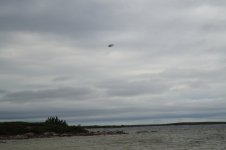
The Float Plane Appeared At 2:00 p.m.
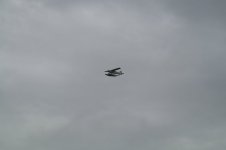
The Float Plane Flew Away At 2:20 p.m.
